Detailed information on the points illustrated on the farm trail map.
1. Veteran Maple Tree
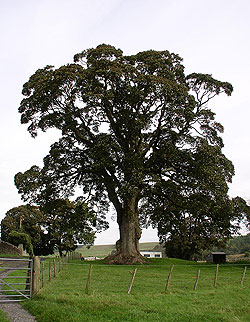 This maple tree is over 400 years old. Lots of insects will live within the tree and these will provide food for birds. Holes in the tree are very important as birds and bats can use these as nesting sites.
This maple tree is over 400 years old. Lots of insects will live within the tree and these will provide food for birds. Holes in the tree are very important as birds and bats can use these as nesting sites.
2. Scrub & Native Woodland
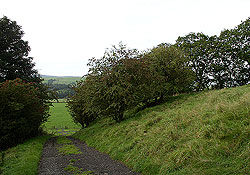 As you walk down the track you will notice a bank of scrub to your right. Species include Hawthorn, Elder, Broom, Dog rose and Blackthorn. Scrub is very important as the berries provide food for a variety of birds and the trees themselves provide important nesting habitat for birds. You may see Robin, Blackbird, Chaffinch & Blue Tit in this habitat.
As you walk down the track you will notice a bank of scrub to your right. Species include Hawthorn, Elder, Broom, Dog rose and Blackthorn. Scrub is very important as the berries provide food for a variety of birds and the trees themselves provide important nesting habitat for birds. You may see Robin, Blackbird, Chaffinch & Blue Tit in this habitat.
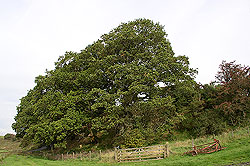 Further down the track to your right is an area of native woodland. This is dominated by Oak, but there are also lovely mature holly trees. The woodland will support a wide variety of insects, butterflies, birds and small mammals. The wood has been fenced off to exclude stock from grazing. This will allow any tree seeds which have fallen to grow, without the risk of stock eating them, and is known as natural regeneration. This habitat is managed in an Agri-environment Scheme, funded by the Scottish Executive.
Further down the track to your right is an area of native woodland. This is dominated by Oak, but there are also lovely mature holly trees. The woodland will support a wide variety of insects, butterflies, birds and small mammals. The wood has been fenced off to exclude stock from grazing. This will allow any tree seeds which have fallen to grow, without the risk of stock eating them, and is known as natural regeneration. This habitat is managed in an Agri-environment Scheme, funded by the Scottish Executive.
3. Drystane Dyke
Dykes are found throughout Dumfries and Galloway and are an important landscape feature. Styles vary within the region, due to the different types and shapes of stone. Wren and wagtail nest in dykes and the stone is often covered in lichens and mosses.
4. River margin
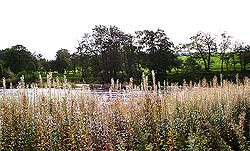 The margin adjacent to the River Nith is not grazed by stock, therefore vegetation has grown up, which acts as a buffer strip, protecting the watercourse from pollution, by filtering any runoff containing items such as soil, nutrients or fertilisers .
The margin adjacent to the River Nith is not grazed by stock, therefore vegetation has grown up, which acts as a buffer strip, protecting the watercourse from pollution, by filtering any runoff containing items such as soil, nutrients or fertilisers .
5. River Nith
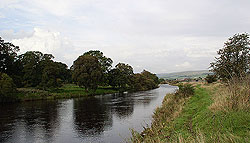 This river is important for salmon and trout and is popular with fishermen. Salmon return to their river of birth in the autumn to spawn. They lay thousands of eggs, in a gravel “nest” called a redd, then most of the adult fish die. Salmon “fry” hatch out and remain in the river for the first few years, before making the trip out to the North Sea.
This river is important for salmon and trout and is popular with fishermen. Salmon return to their river of birth in the autumn to spawn. They lay thousands of eggs, in a gravel “nest” called a redd, then most of the adult fish die. Salmon “fry” hatch out and remain in the river for the first few years, before making the trip out to the North Sea.
6. Open pasture
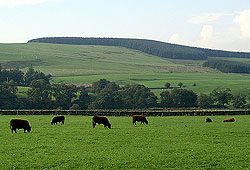 Much of the land on Newark is open improved grassland. This will have fertiliser and manure applied, to add nutrients to the soil, to ensure good grass growth each year. Cattle and sheep graze the farm. These graze in different ways: cattle wrap their tongues around grass pulling it out and can eat tougher, longer grass, whereas sheep have small mouths and nibble grass, they are also more selective feeders.
Much of the land on Newark is open improved grassland. This will have fertiliser and manure applied, to add nutrients to the soil, to ensure good grass growth each year. Cattle and sheep graze the farm. These graze in different ways: cattle wrap their tongues around grass pulling it out and can eat tougher, longer grass, whereas sheep have small mouths and nibble grass, they are also more selective feeders.
7. Sanquhar Castle
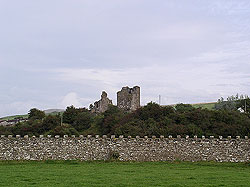 This was built by the Crichton family circa 1400. They chose a strong location, with ground falling steeply to the River Nith to the west and Townfoot Burn to the north. The natural defences were supplemented by a ditch cut around the site. Mary Queen of Scots took refuge in the castle.
This was built by the Crichton family circa 1400. They chose a strong location, with ground falling steeply to the River Nith to the west and Townfoot Burn to the north. The natural defences were supplemented by a ditch cut around the site. Mary Queen of Scots took refuge in the castle.
8. Species-rich grass & woodland
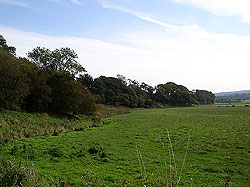 Unimproved, species-rich grassland has no fertiliser or manure applied, to keep nutrient levels low, because wildflowers require low nutrient levels to survive. Insects, butterflies and small mammals will thrive in this habitat.
Unimproved, species-rich grassland has no fertiliser or manure applied, to keep nutrient levels low, because wildflowers require low nutrient levels to survive. Insects, butterflies and small mammals will thrive in this habitat.
9. Take care
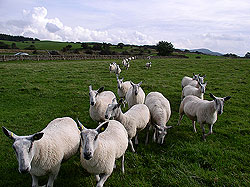 Take care walking along the roadside verge, as cars are moving fast. The small paddocks to the left as you come in the farm drive will have ewes with lambs in spring.
Take care walking along the roadside verge, as cars are moving fast. The small paddocks to the left as you come in the farm drive will have ewes with lambs in spring.